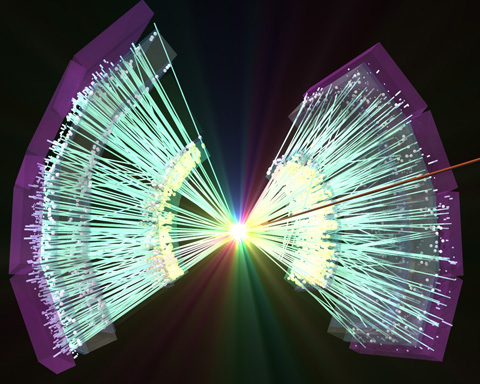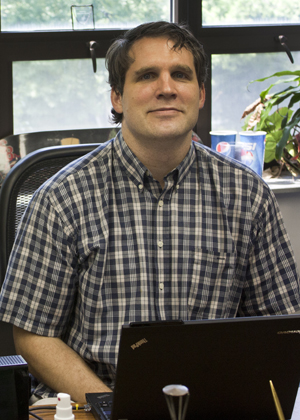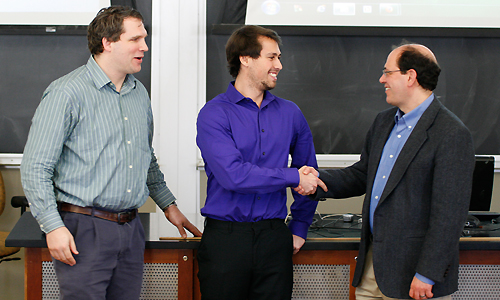As matter “cooks” to 4 trillion degrees Celsius—250,000 times hotter than the center of the sun—protons and neutrons melt into a liquid plasma of quarks and gluons. This liquid may have been present at the start of the universe for a few microseconds.
But Dr. Justin Frantz has an even shorter window to try to measure the particle interactions in this quark-gluon plasma—a billionth of a trillionth of a second before nature’s strongest force pulls the cooling quarks and gluons back into the protons and neutrons that are the building blocks of matter.
Just as doctors use X-rays to see inside the body, Frantz is using very high energy versions of X-rays to see inside the plasma.
A newly awarded NSF grant provides $300,000 in funding to study the incredible properties of the quark-gluon plasma in PHENIX—the Pioneering High Energy Nuclear Interaction eXperiment—at Brookhaven National Laboratory in Upton, NY. Frantz is an Assistant Professor of Physics and Astronomy in the Ohio University College of Arts & Sciences.
Read more about Frantz’ team in “Physicists Unraveling Mysteries about Matter That Makes Up World.”

This “event display” is a snapshot of a very high energy nuclear collision that produces large numbers of outgoing subatomic particles, represented by the straight line “tracks” emanating from the center.
PHENIX is one of two large detector systems in the “pressure cooker” called the Relativistic Heavy Ion Collider, which smashes heavy ions—gold atoms stripped of their electrons—together at a rate of thousands of collisions per second. The primary goal of PHENIX is to discover and study a new state of matter called the quark-gluon plasma.
The incredible properties of the plasma—in addition to it being the most nearly perfect liquid every observed—include its strongly interacting nature. However, the plasma interacts very little with light. So Frantz will be studying these strong interactions using very high energy versions of X-rays called direct photons, produced in the same collisions as the plasma. Like medical X-rays, photons penetrate the plasma and thus provide important information.
“These photons—light particles—can be compared with quarks produced at similar high energies but which should interact more strongly, like the other quark constituents of the plasma,” says Frantz. “In the project this will be done through studying correlations between photons and hadrons, which are particles made of quarks. Measurements of these correlations will be performed primarily using the PHENIX experiment at RHIC.” Frantz’ study also will include some research at the Large Hadron Collider, the world’s largest and most powerful particle accelerator, at CERN in Europe.
“The specific goal of these analysis studies is understanding the newly discovered enhancement of certain types of particles produced by the quarks because of the plasma, at both RHIC with PHENIX and also at the ATLAS experiment at the LHC. For this reason our data analysis will include comparisons to, and possibly some research activities using, the ATLAS experiment as well,” Frantz says.
In addition to these analysis projects, the investigator’s group at Ohio University will continue to support the upgrade of the computing, analysis, and hardware of PHENIX through operation of the PHENIX Sub-Detector called the Lead-Glass Calorimeter Detector. The Lead-Glass Calorimeter Detector is one of a dozen detector sub-systems in PHENIX. Additionally Frantz’s role in leadership of groups and projects of detector development and analysis for PHENIX will continue as part of the new grant. For nearly 10 years, he has been a key part of the management structures of PHENIX which guide the activities of its more than500 collaborating member scientists worldwide.
The NSF grant project, titled “QGP Strong Coupling Mechanisms and Jet Modification Via Direct Photon-Jet Probes, RHIC-PHENIX vs. LHC-ATLAS,” is under the direction of Frantz. The award is effective Aug. 01, 2013, with initial funding of $100,000 and a total of $300,000. http://www.nsf.gov/awardsearch/showAward.do?AwardNumber=1308299
“Although Brookhaven Lab is actually not too far away, I’ve found that I’ve been able to have students working with me on this research, including three graduate students and two undergraduates, who do so remotely, to a large degree. By this I mean we use computers from here at OU to access the data provided by PHENIX, so we often don’t need to physically visit Brookhaven. This helps my group remain more connected and aware of other nuclear physics activities in the department and our local Institute of Nuclear and Particle Physics, INPP, which means the students get a broader exposure to the whole field,” he said.
Frantz’s work looks to make broader benefits to the community and even to society beyond the important goals of its research and the training of young researchers. One way he has been doing this has been to develop and maintain organizations in the state of Ohio and beyond to exchange knowledge within the field of Relativisitic Heavy Ion collisions. Frantz maintains a statewide email list of researchers that includes about 20 people around Ohio, including Ohio State and Kent State. He also has organized two conferences in the area since 2010. One in 2010 about Relativistic Heavy Ions called the “Midwest Critical Mass” workshop brought 30 researchers from six universities in several nearby states as well, including Michigan State, University of Illinois, Wayne State University, and Purdue. And this past March, together with another Nuclear Physics professor in the department, Dr. Kenneth Hicks, he co-organized the Ohio Section meeting of the American Physical Society, in which Ohio University hosted more than 100 researchers, students, and other physicists from dozens of institutions nearby.
Stunning Discoveries: About RHIC—Brookhaven Lab leads the world in exploring how the matter that makes up atomic nuclei behaves in the most extreme conditions possible such as just after the Big Bang. Research at RHIC, the only collider now operating in the United States, has produced a series of stunning discoveries that have captured worldwide attention and showcased U.S. leadership in physics. First and foremost was the unexpected “perfect” liquid nature of the 4-trillion-degree quark-gluon plasma that permeated the early universe. RHIC is now closing in on understanding how the transitions occur going to and from this hot quark-gluon plasma state into ordinary matter made of protons and neutrons—namely everything we see in today’s world.
Recent publications by Frantz:
Justin Frantz: “Prompt Photon Production and Photon-Jet Hadron Correlations in PHENIX,” Nuclear Physics A, Vol. 904-905, May 2013, The Quark Matter 2012 — Proceedings of the XXIII International Conference on Ultrarelativistic Nucleus‒Nucleus Collisions
Medium modification of jet fragmentation in Au+Au collisions at sqrt(s_NN)=200 GeV measured in direct photon-hadron correlations. (PHENIX Collaboration) Accepted for Publication in Physical Review Letters (June 14, 2013) (for now you can find it here http://prl.aps.org/accepted#articles-nuclear-physics or here http://prl.aps.org/accepted/e1079Y8dMc51d838637133d261c39262d09126712
Direct photon production in d+Au collisions at √sNN=200 GeV (PHENIX Collaboration) Physical Review C 87, 054907 (May 17, 2013) http://prc.aps.org/abstract/PRC/v87/i5/e054907
Quadrupole anisotropy in dihadron azimuthal correlations in central d+Au collisions at sqrt(s_NN)=200 GeV (PHENIX Collaboration) Submitted to Physical Review Letters March 13, 2013. http://arxiv.org/abs/1303.1794
Neutral pion production with respect to centrality and reaction plane in Au+Au collisions at √sNN=200 GeV (PHENIX Collaboration) Physical Review C 87, 034911 (March 13, 2013) http://prc.aps.org/abstract/PRC/v87/i3/e034911
Direct photon-hadron and Di-hadron correlations Justin Frantz and Dmitri Kotchetkov (Ohio U.). 2012. J.Phys.Conf.Ser. 389 (2012) 012021




















Comments